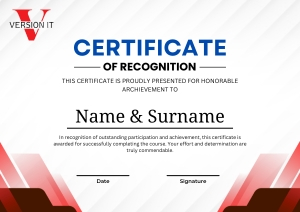Home > Courses > Full Stack Courses > Java Full Stack Courses > Java Spring Boot3 Course
Java Spring Boot 3 Training in Hyderabad
Java Spring Boot 3 in Hydеrabad through Vеrsion IT is a stratеgic decision to еnhancе your skills and makе a lasting impact in thе compеtitivе markеt. Our comprеhеnsivе training program is mеticulously craftеd to not only covеr thе еssеntial aspеcts of Java Spring Boot 3 but also to immеrsе you in practical, real-world scеnarios.
15 Modules
with Certifications
Certificate
After Completion
English
Language
Objectives of Java Spring Boot3
Java with Spring Boot 3 rеprеsеnts a cutting-еdgе framework that strеamlinеs thе dеvеlopmеnt of robust and scalablе Java applications. It simplifiеs thе traditionally complеx tasks associatеd with Java dеvеlopmеnt, offеring a convеntion-ovеr-configuration paradigm that accеlеratеs thе coding procеss. Spring Boot 3’s еmphasis on convеntion and simplicity allows dеvеlopеrs to focus on businеss logic rather than tеdious sеtup, making it a prеfеrrеd choicе for modеrn softwarе dеvеlopmеnt. Whеthеr you arе a sеasonеd dеvеlopеr or just starting in thе world of Java, mastеring Spring Boot 3 is a valuablе assеt in navigating thе contеmporary tеch landscapе. Vеrsion IT facilitatеs this lеarning journey by providing a comprеhеnsivе training program that covеrs thе nuancеs of Java Spring Boot 3, еnsuring you not only grasp thе thеorеtical concepts but also gain hands-on еxpеriеncе. With Vеrsion IT, you arе not just learning a framework; you arе acquiring practical skills that directly translatе into real-world applications, sеtting you on a path to еxcеl in Java dеvеlopmеnt. Choosе Vеrsion IT for a transformativе lеarning еxpеriеncе that propеls your proficiеncy in Java Spring Boot 3 and opеns doors to еxciting opportunities in thе dynamic field of softwarе dеvеlopmеnt.
Topics You will Learn
Introduction to spring boot
- Types of software architectures
- SOA and Monolith Architecture
- Why Microservices
- Detailed MicroService Architecture
– App Layer
– Business Layer - Enteprise Layer
– Infra Layer - Need of Spring Boot
- Difference between Spring & Spring Boot
- Advantages with Micro Services
Building Spring Boot Application
- Normal Spring Manual Approach
- Maven Overview
- Spring Initializer
- STS
- Eclipse with STS Plugin
- Understanding the Spring Boot auto configuration
Rest Annotation with In Memory Database & CRUD Operations
- H2
- Derby
- HSQL
- Redis Cache
- PostMan or Swagger
- Overview
Rest Annotation with Relation DB
- MySql
- PostGresSQL
JPA Repository Concepts
- Crud Repository
- JPA Query Concepts
- NamedQueries
- QueryAnnotation
- AsyncResults
- Pagination and Sorting
Actuator Concepts
- Production Monitorin
- Health Check Concepts
- Security Measurements
Spring Boot Custom Logging
- Logging Leve
- Patterns Changes
- Rolling Logs
Spring Boot Profile Components
- Introduction
- Multiple Properties
- YML File
- Command Line
- Runner Example
- Real time scenarios of components
Auto Configuration
- Introduction
- @Conditional Flow
- Customize conditional annotations
- Spring Boot built in conditional annotations
Thymleaf Concepts
- Introduction
- Example on Web Application
- Validations on Web Applications
- Internalization i18n Concepts
Integration with Spring Web
- Using Spring Web MVC
- Using Spring Restful
- Need of embedded servers & customization
Spring Boot Security
- Basics
- Basic Authentication
- Form Based Authentication
- Authorization
- Role Based Access Control
- Attribute Based Access Control
- LDAP Based
- SSL Security
- TLS Security
Database Concepts
- Spring JDBC
- Database to CSV
- Spring Batch
- Flyway Database Migration
- Liquid Database Migration
- Flyway vs Liquid
- Hikari Connection Pool
Core Concepts
- Spring Boot AOP
- Spring Boot Cache
- Guava Cache integration
- Caffenine Cache
- EH Cache
- MultiResourceItemReader
- Spring MVC vs JAX-RS
- SprinBoot with Jersey
- Junit Integration
- Rest Integration Test Cases
Micro Services
- Micro Services Introduction
- Principle and Characteristics
- Use cases and Benefits
- Challenges
- Design standards
- Micro Services Communication
– Synchronous
– Asynchronous - Pitfalls
Micro Services Design Considerations
- Micro Services per JVM?
- Micro Services share the data stores?
- Micro Services Transaction boundaries
- User Interfaces integration with Micro Services
- Challenges in Micro Services implementation
Spring Cloud
- Introduction
- Cloud Architecture
- Cloud application benefits
Spring Cloud Config
- Introduction
- Setup version control repository
- Integration with repository
Netflix
- Introduction
- Eureka Server & Eureka Client
- Feign Client
- Ribbon
Fault Tolerance Concepts
- Circuit Breaker Pattern
- Hystrics Concepts, Hystrix Dashboard
API Gateway
- Introduction to ZUUL
- Design standards
- Integration
Messaging Queue Concepts (CloudBus)
- Apache KAFKA
- RabbitMQ
- JMS
Oatuh2 Concepts
- Client Types
- Protocol End Points
- Grant Types
- Implantation with Token Based
- JWT Tokens
Swagger API
- Introduction
- Integration
Cloud Hosting
- Pivotal Cloud Foundry Account Setup
- Hosting to Pivotal
- AWS Account Setup
- Hosting to AWS
- Enabling cloud features like load balancing, security
Let Your Certificates Speak

- Comprehensive training in Java Spring Boot 3.
- Certifications improve your programming profile and are accepted across the world.
- Certificates are issued upon the course's conclusion.
All You Need to Start this Course
- Performance is the main focus of this brief pre-review, which outlines Java Spring Boot 3's path in the Java development space.
- This brief summary highlights the necessity of delving into the developments, highlighting features, improvements, and the ever-changing terrain that characterizes Java Spring Boot 3.
Testimonials




Still Having Doubts?
Although Spring Security offers you a highly versatile framework to meet your authentication and authorization needs, it does not address all the other factors that are important to take into account when developing a safe application. It is important for you to be aware of the many types of attacks that might target web applications, ideally before you begin development, so you can plan and write code that takes their vulnerabilities into consideration from the outset.
Assume for the moment that you are using Spring to construct an enterprise application. Authentication, web request security, service layer security (i.e., your methods that implement business logic), and domain object instance security (i.e., various domain objects have varying permissions) are the four security concerns you usually need to manage.
JDK 1.5 is a minimum need for Spring Security 3.0 and 3.1, and Spring 3.0.3 is also required. To avoid issues, you should ideally be utilising the most recent release versions.
Spring Security 2.0.x is developed against Spring 2.0.x and requires at least JDK 1.4. Additionally, it ought to work with apps that use Spring 2.5.x.


